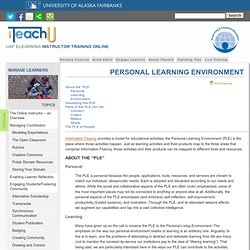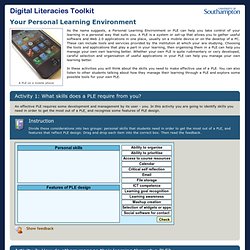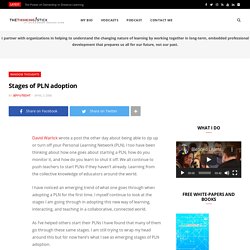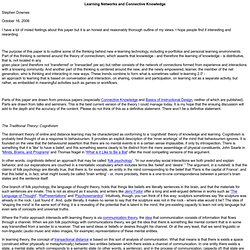

Personal Learning Environments. PLE Diagrams. ~ Stephen's Web. By Stephen DownesOctober 26, 2006 Another attempt - this time using Gliffy - to illustrate my own thinking about what a PLE should entail.

I created a demo of a part of this concept ages ago, here - it is never listed as among the "examples of PLEs" but is in fact a first draft of what I think a PLE should look like (I promise to lose the yellow, though). It doesn't really work in Internet Explorer, but it works just fine in Firefox. Enclosure: Comments You are not logged in. You can preview your comment and continue editing until you are satisfied with it. Your comments always remain your property, but in posting them here you agree to license under the same terms as this site CC By-NC-SA.
Automated Spam-checking is in effect. A Simple Comprehensive Guide on The use of Personal Learning Networks in Education. Personal Learning Networks, or PLNs, have been around for a long time.

Originally they were your family, relatives and friends, or probably other educators and fellow teachers you work with in the same institution, but now and thanks to the development of web technologies and wireless connections, the concept of PLNs has been expanded to engulf people you have never met before in real world. Much of the learning nowadays takes place online and via a network of interconnected relations. PLNs are basically based on the concept of a learning community. Teachers who are passionate about developing their learning experiences recognize the value of sharing their knowledge and expertise with others.
Infographic: #PLearning Framework (Part 2 of the Series) - Getting Smart by Guest Author - learning, personalized learning, plearning, students. By: Justin DeLeon #PLearning Framework (Part 2 of the Series) first appeared on Education Elements on April 2, 2014.

When you think of “personalized,” you probably think “unique,” “special,” and “just for me.” For the most part, we personalize as much of our lives as possible. We stock our cabinets and fridges with food based on our dietary needs and what we enjoy eating. We pick apps for our phones based on what we need to do in our daily lives and what we enjoy doing (e.g., banking or launching cartoon birds with a slingshot). Applying the idea of personalization to our phones or what we eat is fairly straight-forward. Take a deep breath. Drivers: Needs and Goals. Personal Learning Environment. Information Fluency provides a model for educational activities; the Personal Learning Environment (PLE) is the place where those activities happen.

Just as learning activities and their products map to the three areas that comprise Information Fluency, those activities and their products can be mapped to different tools and resources. About the “PLE” Personal The PLE is personal because the people, applications, tools, resources, and services are chosen to match our individual, idiosyncratic needs. Each is adopted and discarded according to our needs and whims. Learning Many have given up on the call to rename the PLE to the Personal Living Environment. Environment In practice, the PLE is an environment, not a network. Visualizing the PLE Visualizing the PLE has become something of a pastime for education technology geeks. Similarly, Martin Weller clusters tools and services around himself, clustered by (primary) function:
Your Personal Learning Environment. A PLE on a mobile phone As the name suggests, a Personal Learning Environment or PLE can help you take control of your learning in a personal way that suits you.

A PLE is a system or set-up that allows you to gather useful software and Web 2.0 applications in one place, usually on a mobile device or on the desktop of a PC. These can include tools and services provided by the institution at which your are studying. Stages of PLN adoption. David Warlick wrote a post the other day about being able to zip up or turn off your Personal Learning Network (PLN).

I too have been thinking about how one goes about starting a PLN, how do you monitor it, and how do you learn to shut it off. We all continue to push teachers to start PLNs if they haven’t already. Learning from the collective knowledge of educators around the world. I have noticed an emerging trend of what one goes through when adopting a PLN for the first time. I myself continue to look at the stages I am going through in adopting this new way of learning, interacting, and teaching in a collaborative, connected world.
As I’ve helped others start their PLNs I have found that many of them go through these same stages. Paper92. Learning Networks and Connective Knowledge Stephen Downes October 16, 2006 I have a lot of mixed feelings about this paper but it is an honest and reasonably thorough outline of my views.

I hope people find it interesting and rewarding. The purpose of this paper is to outline some of the thinking behind new e-learning technology, including e-portfolios and personal learning environments. Parts of this paper are drawn from previous papers (especially Connective Knowledge and Basics of Instructional Design, neither of which are published). The Traditional Theory: Cognitivism.